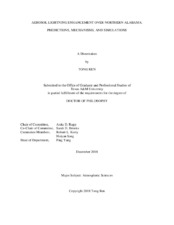| dc.description.abstract | Satellite aerosol retrievals, ground-based radar and lightning detections, and model simulations are used to study the impact of aerosols on lightning and the usefulness of knowing the aerosol state in predicting enhanced lightning over northern Alabama. The results show that the Moderate Resolution Imaging Spectroradiometer (MODIS) aerosol optical depth (AOD) retrievals are less useful in predicting enhanced lightning flash rate (FR) for lightning-producing storms than the forecasts of other meteorological variables that are more closely linked to the intensification of convective storms. However, when relatively weaker convective available potential energy (CAPE) is forecast, the probability of enhanced lightning FR increases in a more polluted environment, making the knowledge of aerosols more useful in lightning inference in such CAPE regimes. The FR shows a stronger correlation with the optical depth of absorbing aerosols than that of non-absorbing aerosols, particularly in a low CAPE regime, suggestive of a potentially stronger regulation of storms by absorbing aerosols. The presence of absorbing aerosols may lead to the accumulation of CAPE, as suggested by an increased correlation between AOD and CAPE in the presence of absorbing aerosols. The optical depth of absorbing aerosols shows a weak negative correlation with the planetary boundary layer height (PBLH), suggesting that the interaction between absorbing aerosols and turbulent mixing may contribute to the regulation of lightning-producing storms. Aerosol enhancement of lightning may be associated with enhanced convergence in the boundary layer and secondary convection, which appears to result from a synthesis of multiple mechanisms related to both microphysical and radiative effects of aerosols. The impact of absorbing aerosols on deep convection is sensitive to the height of aerosol layer. A sensitivity modeling study suggests that a daytime heating layer above the PBL suppresses deep convection in the early afternoon and enhances nighttime storms when the accumulated CAPE is released. A daytime heating layer within the PBL delays the onset of the enhanced nighttime storms and may result in a faster development of the storms at night; the enhanced evaporation of cloud and rain water droplets right before the onset of nighttime storms may contribute to the onset delay. | en |


